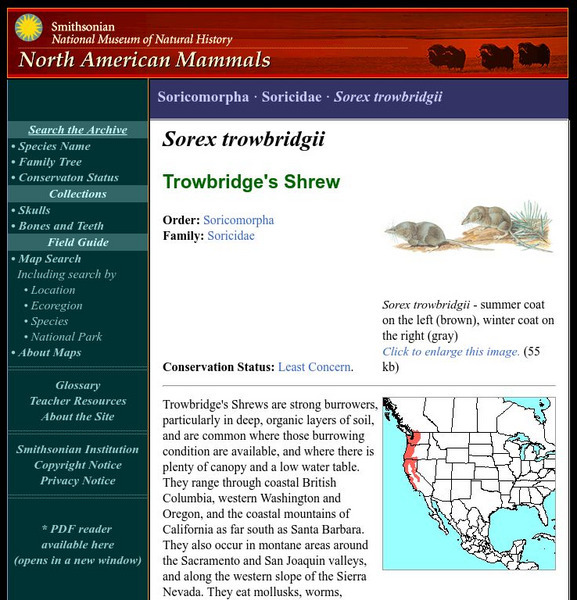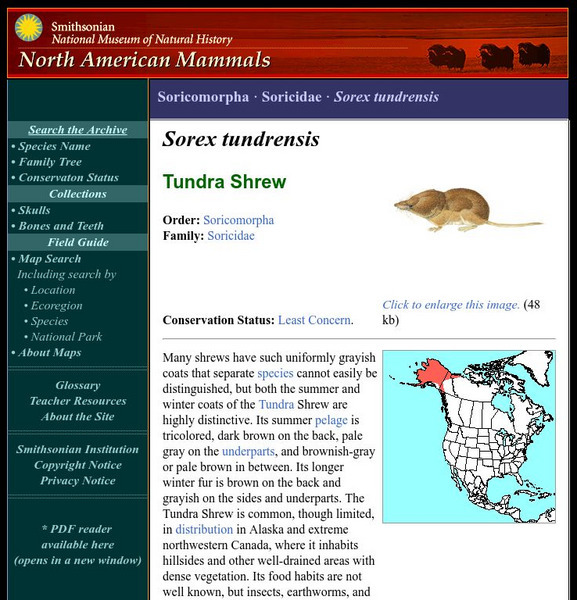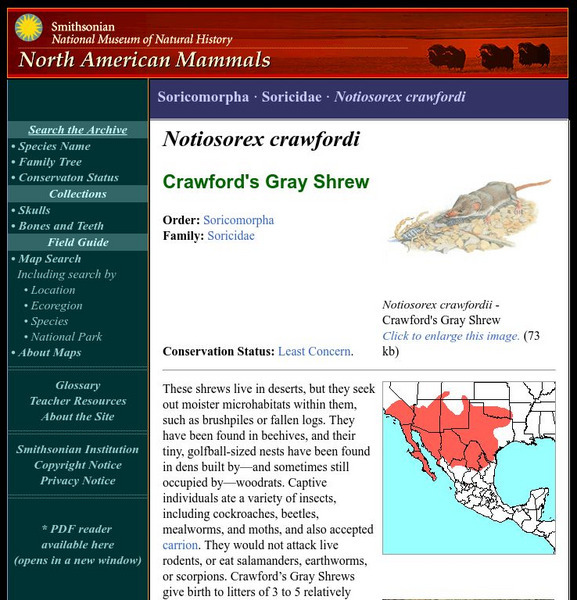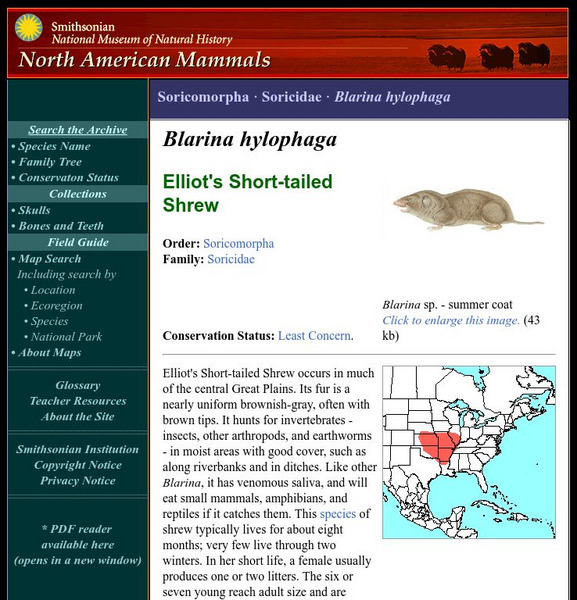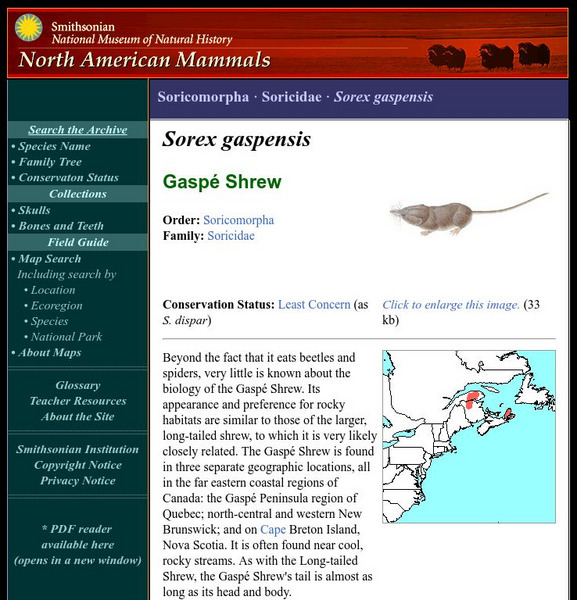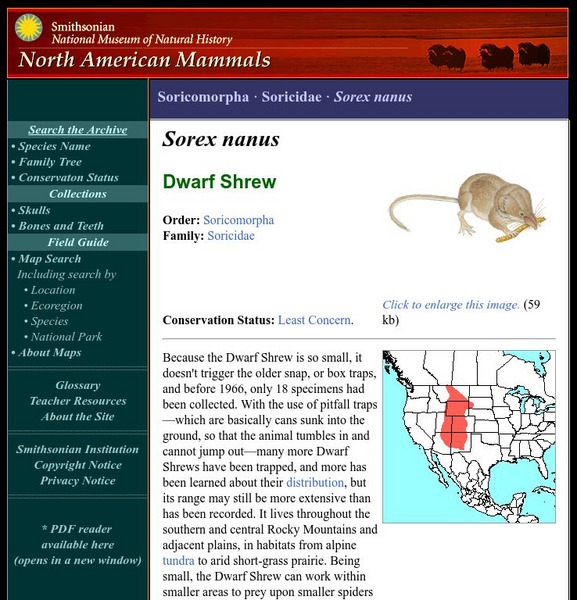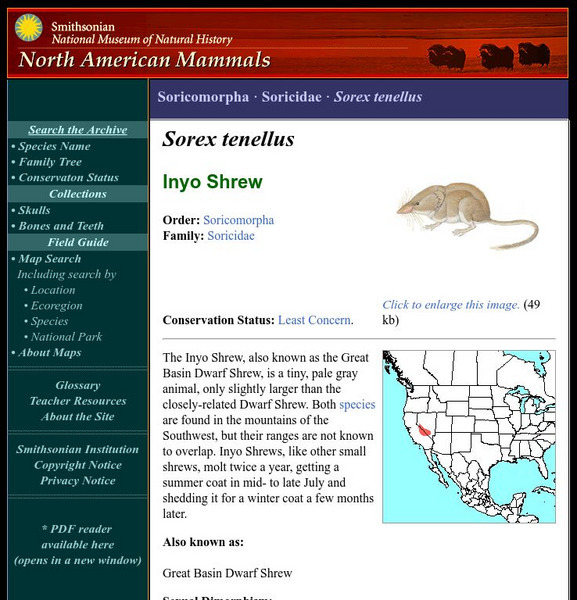Smithsonian Institution
National Museum of Natural History: American Mammals: Pribilof Island Shrew
The Pribilof Island Shrew lives in maritime tundra on St. Paul Island, and almost nothing is known about its biology. Learn more about the Sorex pribilofensis, more commonly known as a Pribilof Island Shrew, in this easy-to-read species...
Smithsonian Institution
National Museum of Natural History: American Mammals: Trowbridge's Shrew
Trowbridge's Shrews are strong burrowers, particularly in deep, organic layers of soil, and are common where those burrowing condition are available, and where there is plenty of canopy and a low water table. They range through coastal...
Smithsonian Institution
National Museum of Natural History: American Mammals: Vagrant Shrew
Vagrant Shrews live in moist habitats throughout their range. They are common in lakeside or streamside communities of sedges, grasses, and willows, and in coastal salt marshes. Learn more about the Sorex vagrans, more commonly known as...
Smithsonian Institution
National Museum of Natural History: American Mammals: Tundra Shrew
Many shrews have such uniformly grayish coats that separate species cannot easily be distinguished, but both the summer and winter coats of the Tundra Shrew are highly distinctive. Its summer pelage is tricolored, dark brown on the back,...
Smithsonian Institution
National Museum of Natural History: American Mammals: Preble's Shrew
Very little is known about the natural history of Preble's Shrew, which has been found in widely separate localities in much of the western United States. Specimens have been collected at elevations of 1,280 m in Oregon and 2,750 m in...
Smithsonian Institution
National Museum of Natural History: American Mammals: Crawford's Gray Shrew
These shrews live in deserts, but they seek out moister microhabitats within them, such as brush piles or fallen logs. They have been found in beehives, and their tiny, golfball-sized nests have been found in dens built by and sometimes...
Smithsonian Institution
National Museum of Natural History: American Mammals: Elliot's Short Tailed Shrew
Elliot's Short-tailed Shrew occurs in much of the central Great Plains. Its fur is a nearly uniform brownish-gray, often with brown tips. Learn more about the Blarina hylophaga, more commonly known as Elliot's Short-tailed Shrew, in this...
Smithsonian Institution
National Museum of Natural History: American Mammals: Gaspae' Shrew
Beyond the fact that it eats beetles and spiders, very little is known about the biology of the Gaspe Shrew. Its appearance and preference for rocky habitats are similar to those of the larger, long-tailed shrew, to which it is very...
Smithsonian Institution
National Museum of Natural History: American Mammals: Fog Shrew
Fog Shrews are the largest of the Pacific Coast brown shrews, and inhabit what is known as the fog belt of Oregon and California, near and along the coast. They live in redwood or dense spruce forests, in marshes, near streams, and under...
Smithsonian Institution
National Museum of Natural History: American Mammals: Dwarf Shrew
Because the Dwarf Shrew is so small, it doesn't trigger the older snap or box traps, and before 1966, only 18 specimens had been collected. With the use of pitfall traps, which are basically cans sunk into the ground so that the animal...
Smithsonian Institution
National Museum of Natural History: American Mammals: Inyo Shrew
The Inyo Shrew, also known as the Great Basin Dwarf Shrew, is a tiny, pale gray animal, only slightly larger than the closely-related Dwarf Shrew. Both species are found in the mountains of the Southwest, but their ranges are not known...
Smithsonian Institution
National Museum of Natural History: American Mammals: North American Least Shrew
North American Least Shrews have a repertoire of tiny calls, audible to human ears up to a distance of only 20 inches or so. Nests are of leaves or grasses in some hidden place, such as on the ground under a cabbage palm leaf or in...
Curated OER
Bbc Nature: Wildlife: Rufous Elephant Shrew
Close-up image of the rufous elephant shrew, an African mouse-like animal.



